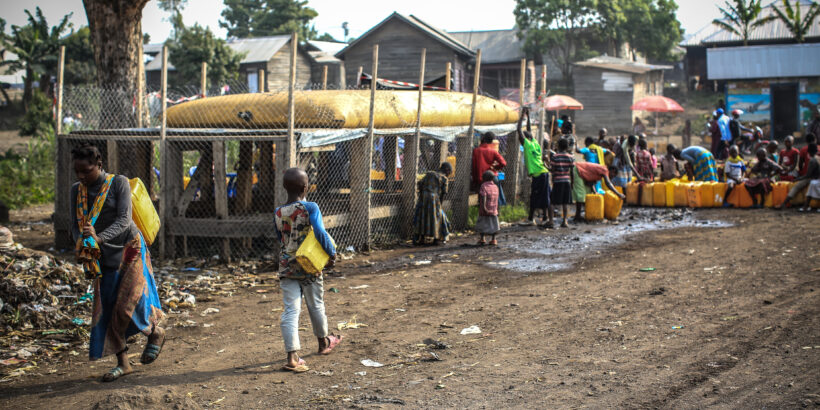Our world is as mobile and transient as ever. As of June 2022, there were more than 27 million refugees and more than 53 million internally displaced persons (IDPs), forced from their homes due to conflict, persecution, and natural disaster. This is a staggering testament to the magnitude of people uprooted from their homes and communities, largely due to circumstances outside of their control.
Refugees and IDPs often arrive in neighboring communities or countries where healthcare and infrastructure systems are overwhelmed and not capable of handling the mass influx of people. Refugee and IDP camps are often intended to be temporary structures, and are overcrowded, have limited safe water, and lack improved sanitation. These conditions allow infectious diseases such as typhoid to spread quickly. Compounded with the lack of healthcare, timely diagnosis, and treatment of disease like typhoid can lead to complications and increased rates of morbidity and mortality.
In honor of this year’s World Refugee Day, we recognize some of the refugee and IDP populations that must still be reached with appropriate healthcare, including vaccines. All vaccines, including TCV, are important preventative health tools that must be afforded to all children, regardless of where they live, so that as they move—whether as refugees, IDPs, migrants, or other mobile groups—they are protected against typhoid.
Water insecurity brings increased risks to refugees
Local conflict in Burkina Faso has led to an internally displaced population of nearly 2 million people. Non-state armed groups have attacked crucial water points, cutting water access for more than 830,000 people. Without access to clean water, the risk of waterborne disease increases quickly. People are more likely to consume unsafe or contaminated water that may contain pathogens such as S. Typhi when clean, safe water is unavailable. The instability has forced people away from their communities and local health systems, compounding the risks of severe disease.
Political insecurity and ongoing conflict continue to plague the Democratic Republic of Congo (DRC). In North Kivu province alone, more than 1.3 million people have been displaced and many have temporarily settled in the regional capital of Goma, stretching infrastructure and health systems. Recent years have seen an uptick in both typhoid and cholera cases. DRC has seen localized outbreaks of typhoid, most recently in Kwango province where more than 1,800 typhoid cases have been reported since the beginning of 2023. The widespread lack of access to clean water and safe sanitation, coupled with lack of access to TCV, means that internally displaced and mobile populations are at high risk for typhoid and other waterborne diseases.
Nearly one million Rohingya refugees have settled in Cox Bazar, Bangladesh, after fleeing horrific persecution in their home country, making Cox Bazar the world’s largest refugee camp. As population numbers have swelled, the makeshift camp, mostly filled with bamboo shelters and tarped roofs, has not been able to keep pace with water and sanitation infrastructure. Monsoon season in Bangladesh is particularly worrying when the lack of proper water supplies puts the community at increased risk of disease such as typhoid and cholera.
Climate disasters rapidly displace populations
In October 2022, an extreme monsoon season brought unprecedented flooding to Pakistan, displacing millions of people and wreaking havoc on basic water and sanitation infrastructure. Pakistan has introduced TCV, and it is available during the 9-month routine health visit. More than 30 million children have been vaccinated with TCV in Pakistan, which is crucial for children and families. Even today, more than 1.8 million people still live near stagnant or contaminated floodwater. Climate-related events are often unpredictable, reminding us that vaccines must be available to protect children before extreme weather strikes.
In March, Cyclone Freddy brought destruction to the southern region of Malawi, including record breaking floods that forced people to temporarily flee their homes. With limited access to water and sanitation, and loss of access to health care, hundreds of thousands of Malawians were at increased risk for typhoid and other waterborne infections. With concerted effort and planning, the government of Malawi introduced TCV in May 2023, bringing typhoid protection to millions of children.
Prioritizing preventative care
Without access to clean water, safe sanitation, primary healthcare, and vaccines, children are at incredible risk for typhoid and long-term complications. Regardless of where a child is born, they must be vaccinated to protect against future diseases. By routinely vaccinating children, there is one less stressor and burden when forced to flee conflict, persecution, and natural disasters. Today, as we recognize the world’s million refugees and IDPs, we call on policymakers to consider TCV introduction to protect children and families from typhoid.
Photo: Individuals gather water in Goma, DRC. Credit: PATH/Ley Uwera.



